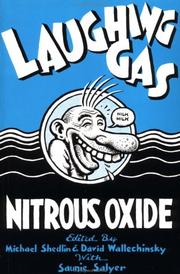| Listing 1 - 10 of 82 | << page >> |
Sort by
|

ISBN: 9780333316818 0333316819 Year: 1982 Publisher: London Scientific and Medical Division, Macmillan Publishers
Abstract | Keywords | Export | Availability | Bookmark
 Loading...
Loading...Choose an application
- Reference Manager
- EndNote
- RefWorks (Direct export to RefWorks)
Nitrous oxide --- Anesthesia --- Nitrous Oxide --- History --- history
Book
Year: 1973 Publisher: Washington, [D.C.] : U.S. Dept. of Commerce, National Bureau of Standards,
Abstract | Keywords | Export | Availability | Bookmark
 Loading...
Loading...Choose an application
- Reference Manager
- EndNote
- RefWorks (Direct export to RefWorks)
Dissertation
ISBN: 9789059896437 Year: 2016 Publisher: Gent Universiteit Gent. Faculteit Bio-ingenieurswetenschappen
Abstract | Keywords | Export | Availability | Bookmark
 Loading...
Loading...Choose an application
- Reference Manager
- EndNote
- RefWorks (Direct export to RefWorks)
Theses --- 661.981 --- Nitrous oxide --- 661.981 Nitrous oxide
Book
Year: 2010 Publisher: [Washington, D.C.] : U.S. Environmental Protection Agency, Office of Atmospheric Programs,
Abstract | Keywords | Export | Availability | Bookmark
 Loading...
Loading...Choose an application
- Reference Manager
- EndNote
- RefWorks (Direct export to RefWorks)

ISBN: 0914171526 9780914171522 Year: 1992 Publisher: Berkeley Ronin Publishing
Abstract | Keywords | Export | Availability | Bookmark
 Loading...
Loading...Choose an application
- Reference Manager
- EndNote
- RefWorks (Direct export to RefWorks)
Nitrous oxide --- Physiological effect --- History
Book
Year: 1999 Publisher: Gaithersburg, MD : U.S. Dept. of Commerce, Technology Administration, National Institute of Standards and Technology, Building and Fire Research Laboratory,
Abstract | Keywords | Export | Availability | Bookmark
 Loading...
Loading...Choose an application
- Reference Manager
- EndNote
- RefWorks (Direct export to RefWorks)
Combustion --- Carbon monoxide. --- Nitrous oxide. --- Measurement.
Dissertation
Abstract | Keywords | Export | Availability | Bookmark
 Loading...
Loading...Choose an application
- Reference Manager
- EndNote
- RefWorks (Direct export to RefWorks)
Nitrous Oxide --- Physostigmine --- administration & dosage --- pharmacology
Book
Year: 1905 Publisher: Paris : J.-B. Baillière et fils,
Abstract | Keywords | Export | Availability | Bookmark
 Loading...
Loading...Choose an application
- Reference Manager
- EndNote
- RefWorks (Direct export to RefWorks)
Medicine. --- Nitrous oxide. --- Anesthesia. --- Nitrous Oxide --- Anesthesia, General --- Medicine --- Médecine. --- Oxyde de diazote. --- Anesthésie. --- medicines (material) --- nitrous oxide. --- medicine (discipline) --- Nitrous oxide --- Anesthesia --- Medicine
Book
ISBN: 9781844077571 1844077578 Year: 2010 Publisher: London Washington, DC : Earthscan,
Abstract | Keywords | Export | Availability | Bookmark
 Loading...
Loading...Choose an application
- Reference Manager
- EndNote
- RefWorks (Direct export to RefWorks)
"Nitrous oxide, N2O, is the third most important (in global warming terms) of the greenhouse gases, after carbon dioxide and methane. As this book describes, although it only comprises 320 parts per billion of the earth's atmosphere, it has a so-called Global Warming Potential nearly 300 times greater than that of carbon dioxide. N2O emissions are difficult to estimate, because they are predominantly biogenic in origin. The N2O is formed in soils and oceans throughout the world, by the microbial processes of nitrification and denitrification, that utilise the reactive N compounds ammonium and nitrate, respectively. These forms of nitrogen are released during the natural biogeochemical nitrogen cycle, but are also released by human activity. In fact, the quantity of these compounds entering the biosphere has virtually doubled since the beginning of the industrial age, and this increase has been matched by a corresponding increase in N2O emissions. The largest source is now agriculture, driven mainly by the use of synthetic nitrogen fertilisers. The other major diffuse source derives from release of NOx into the atmosphere from fossil fuel combustion and biomass burning, as well as ammonia from livestock manure. Some N2O also comes directly from combustion, and from two processes in the chemical industry: the production of nitric acid, and the production of adipic acid, used in nylon manufacture. Action is being taken to curb the industrial point-source emissions of N2O, but measures to limit or reduce agricultural emissions are inherently more difficult to devise. As we enter an era in which measures are being explored to reduce fossil fuel use and/or capture or sequester the CO2 emissions from the fuel, it is likely that the relative importance of N2O in the 'Kyoto basket' of greenhouse gases will increase, because comparable mitigation measures for N2O are inherently more difficult, and because expansion of the land area devoted to crops, to feed the increasing global population and to accommodate the current development of biofuels, is likely to lead to an increase in N fertiliser use, and thus N2O emission, worldwide. The aim of this book is to provide a synthesis of scientific information on the primary sources and sinks of nitrous oxide and an assessment of likely trends in atmospheric concentrations over the next century and the potential for mitigation measures"--Publisher's description.
Atmospheric nitrous oxide --- Nitrous oxide --- Greenhouse gas mitigation. --- Agricultural pollution. --- Climatic changes. --- Environmental aspects.
Book
Year: 2009 Publisher: Bruxelles: UCL,
Abstract | Keywords | Export | Availability | Bookmark
 Loading...
Loading...Choose an application
- Reference Manager
- EndNote
- RefWorks (Direct export to RefWorks)
Since the beginning of their use, 150 years ago, general anesthetics are used usually although their mechanisms of action are not exactly know. With current technology, an important step has been done in their understanding. With this, there is an increasing safety in their use. Indeed, we know the involvement of receptors such as GABA, NMDA receptors, ... as the center of the effect of general anesthetics. However, it remains, at present, many unanswered questions ... This work synthesizes the knowledge on this subject Depuis le début de leur utilisation, il y a 150 ans, les anesthésiques généraux sont utilisés couramment, alors que l’on ne connait pas exactement tous les mécanismes d’actions. Grâce aux techniques actuelles, un grand pas dans la compréhension de leurs fonctionnements a été franchi. Ce qui a permis d’augmenter grandement la sécurité de leur utilisation. En effet, on sait maintenant l’implication de récepteurs tels que le GABA, les récepteurs NMDA, … comme étant au centre de l’effet des anesthésiques généraux. Cependant, il reste encore, à l’heure actuelle, beaucoup de questions sans réponse… Ce travail synthétise l’essentiel des connaissances sur le sujet
Anesthetics, General --- Nitrous Oxide --- Halogens --- Propofol --- Ketamine --- Analgesics, Opioid
| Listing 1 - 10 of 82 | << page >> |
Sort by
|

 Search
Search Feedback
Feedback About UniCat
About UniCat  Help
Help News
News